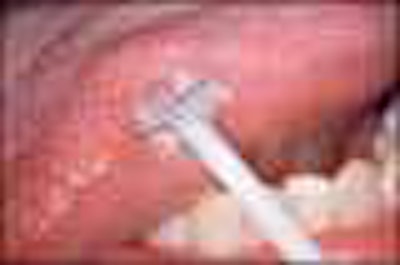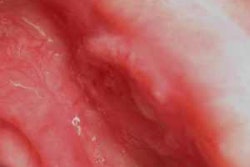
Controversial advertising in an ADA-endorsed oral cancer awareness campaign is likely to change, according to the campaign's sponsor.
The advertising, which began appearing on buses, trains, and in magazines in September 2007, has drawn criticism for two reasons. Some experts, including prominent oral pathologists, have faulted the way the nonprofit ADA is working with the for-profit OralCDx Laboratories. Others have challenged the reliability of the company's BrushTest as a means of detecting precancerous cells.
OralCDx CEO Mark Rutenberg on Tuesday released to DrBicuspid.com the draft of a new disclaimer that he hopes will clarify the relationship between the two organizations. But in an interview, he and company president Howard Kramer maintained that the test is highly accurate. And in an earlier interview, ADA president Mark Feldman, D.D.S., defended the text of the ads as they stand.
The price of promotion
Just about everyone agrees with the goal of raising awareness about oral cancer. An estimated 34,360 Americans are diagnosed with the disease each year, and on average only half of those who are diagnosed survive more than five years, according to the ADA.
|
How accurate is the BrushTest? Since at least 1999, leading experts have debated the accuracy of OralCDx's BrushTest, with editorials, rebuttals, and counter-rebuttals filling the pages of leading journals. Proponents of the test most often cite a 1999 double-blind comparison of the BrushTest to scalpel biopsy, published in a Journal of the American Dental Association study (JADA, September 1999, Vol. 130, pp. 1445-1457). The study was funded by OralCDx Laboratories and involved 35 academic study sites and 945 patients. It concluded that the BrushTest "independently detected every case of histologically confirmed oral dysplasia and carcinoma," with near-perfect results: 100% sensitivity, a false-negative rate of 0%, 100% specificity for a positive result, and 92.9% specificity for an atypical result. However, one of the participating sites, the Scripps Oral Pathology Service, withdrew from the JADA paper because of "serious weaknesses ... in the study and the statistics of the results," according to Gordon M. Rick, director. In June 2003, a team from Indiana University took the BrushTest to task for its record on false negatives. Retrospectively reviewing 115 cases of malignant oral cancer, the researchers found that four had previously been found negative when biopsied by the BrushTest. Their results were published in the Journal of Oral Maxillofacial Surgery (June 2003, Vol. 61:6, pp. 674-677). Then in 2004 came good news and bad news for the BrushTest. A German study on 103 BrushTest results, published in the September 2004 Oral Oncology (Vol. 40:8, pp. 824-828), gave the test a thumbs up, with sensitivity and specificity scores above 90%. But another study in the same issue (Vol. 40:8, pp. 829-834) on 112 patients, conducted by the University of London's Eastman Dental Institute and Hospital, reported lower numbers. Researchers found the test to have a sensitivity of 71.4% and a specificity of 32%. People with dysplasia tested positive 71.4% of the time and people without dysplasia tested positive 68% of the time. Experts disagree on how to make sense of these conflicting numbers, so the controversy continues. |
And even some of the campaign's most prominent critics accept the approach of raising money from a private company. "The oral cancer campaign is important," Mark Lingen, D.D.S., Ph.D., a University of Chicago associate professor of pathology, told DrBicuspid.com. "And you have to pay for it somehow."
OralCDx is paying the entire cost of the $9.5 million, three-year campaign (something the ADA disclosed from the beginning). In fact, as Rutenberg pointed out, OralCDx isn't giving the ADA any money. "We have never given the ADA a dime," he said. "We have committed to spend $9.5 million on advertising. The ADA doesn't get that money. The ad companies get that money."
So what's the beef? In its most controversial version (click here to view the ad), the ad is labeled "IMPORTANT MESSAGE ABOUT ORAL CANCER FROM THE ADA." A headline reads, "Ask your dentist about a routine test as powerful as a Pap smear or colonoscopy." The next sentence reads, "Ask your dentist if a BrushTest can help you by accurately detecting unhealthy cells -- years before they can turn into cancer." The ad also bears the ADA's logo, and the academy's name appears in three other places.
Critics say the ads make it look as though the ADA is endorsing the BrushTest and ignoring competing tests. "I don't think it's appropriate to have a campaign that says, 'Go get this product,'" Dr. Lingen told DrBicuspid.com. "We have not had a campaign that says, 'Brush twice a day with Colgate toothpaste.'"
Dr. Lingen made that point at length in an editorial published in the April 2008 issue of Oral Surgery, Oral Medicine, Oral Pathology, Oral Radiology, and Endodontology (OOOOE, April 2008, Vol. 105, pp. 407-409), where he serves as an editor. He's not satisfied with the fine-print disclaimer currently on the ad, which says that the ADA doesn't endorse a particular product. "One cannot have it both ways," he wrote. "You cannot develop an awareness campaign that focuses on a specific product and at the same time claim that you are not endorsing a product."
"Frankly, I agree with him on that point," Rutenberg said. He explained that people who read the ad should understand that the ADA is endorsing brush biopsy in general, not the BrushTest in particular. The current disclaimer doesn't go far enough in that direction, he added.
The current disclaimer reads, "The ADA does not endorse any specific product in connection with this awareness campaign and has no financial interest in the product featured here. For more information on oral cancer, visit www.ada.org. Part of an education campaign underwritten by OralCDx Laboratories."
The proposed new disclaimer provided to DrBicuspid.com by Rutenberg reads, "The OralCDx brand of brush test is an adjunct to the professional oral examination in the early detection of oral precancer. This test is not a substitute for a scalpel biopsy, which should continue to be utilized to evaluate suspicious oral lesions. The ADA has no financial interest in this product. This poster is part of an educational program supported by a grant from Oral Cancer Prevention International, Inc., provider of the OralCDx brand of brush test. For more information please visit www.ada.org."
Rutenberg said his company is close to agreeing with the ADA on the new draft. He also said he'd like to see less overall text on the ads, which are too "wordy."
But he didn't foresee any change in the headline that compares the brush biopsy to a Pap smear and colonoscopy. And he acknowledged that the OralCDx BrushTest dominates the market for brush biopsy tests. In fact, he said, the company's patents for the technology make it difficult for competitors to mount a challenge.
As for the ADA, Dr. Feldman defended the ads as they are. "The campaign is not product-specific at all," he told DrBicuspid.com. "The message with the ADA logo informs patients to ask their dentists about a test as powerful as a Pap smear or colonoscopy."
Tracking oral cancer
Is a brush biopsy indeed "as powerful" as a Pap smear or colonoscopy? If so, it could have great benefits. Some dentists "frequently don't examine the oral mucosa carefully and have inadequate experience in the identification of lesions," noted Martin S. Greenberg, D.D.S., oral medicine section editor at OOOOE and chair of the department of oral medicine at Penn Dental Medicine, in an OOOOE editorial. If a dentist does find something suspicious, the next step is to send the patient out to an oral surgeon or oral pathologist for a scalpel biopsy.
On the other hand, brush biopsy devices like the BrushTest let a dentist collect cells from suspicious white or red spots in the patient's mouth with much less discomfort; the sample is sent to an OralCDx laboratory for diagnosis. If the cells are abnormal, then a scalpel biopsy can confirm a potential cancer and the spot can be removed.
"The lifesaving reality and potential of the BrushTest is very obvious, and we seek to apply this in all dental offices across the country," said James Sciubba, D.M.D., Ph.D., a Johns Hopkins University pathologist, at a November ADA media briefing announcing the new oral cancer awareness campaign.
But Dr. Lingen believes that the BrushTest should not be compared to the Pap smear and colonoscopy. "Drawing analogies between these two tests and brush cytology is inaccurate," he wrote in his OOOOE editorial. For example, if there's evidence of some type of pathology during a colonoscopy, the patient receives a definitive diagnosis because the lesion is biopsied on the spot and histologically diagnosed. "Oral brush cytology never results in a definitive diagnosis," he wrote.
More to the point, should the BrushTest be your first choice? "The OralCDx procedure is neither optimum nor in the patient's best interest. Why go through the convoluted path [of BrushTest followed by a scalpel biopsy] to get definitive results?" said Dolphine Oda, B.D.S., M.Sc., a professor of oral pathology at the University of Washington.
"A scalpel biopsy is still the gold standard," said Gordon M. Rick, D.D.S., M.S., director of the Scripps Oral Pathology Service. "Why waste time and money on something else?"
To these criticisms, Rutenberg responds that a brush test saves patients the discomfort of having all their lesions tested by scalpel.
To see how Dr. Lingen thinks dentists should detect oral cancer, click here.
Rutenberg also questions the motives of some critics, who he says are afraid the BrushTest will undermine their business interests. "Some oral pathologists are concerned that the OralCDx brush biopsy is somehow competitive with the scalpel biopsy," he said, although he thinks the test will actually drive more business to practitioners of scalpel biopsy.
So far the ADA -- which stirred controversy in 2002 in a similar collaboration with OralCDx -- remains firm in its position on one side of the debate. "If research came out that said that the [BrushTest] is not accurate, then we would obviously have to shut down this campaign and remove our seal," Dr. Feldman said.
But he thinks that's unlikely. He believes the campaign will save lives by getting people into the dentists' office. "That's what this is all about," he said.


















